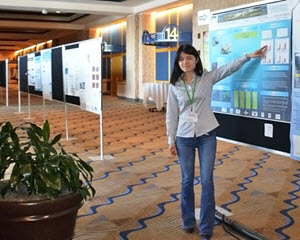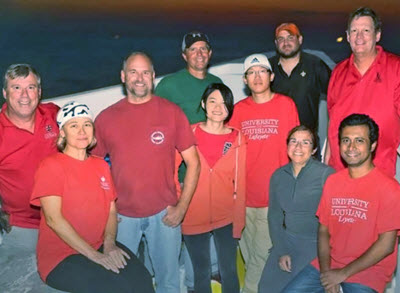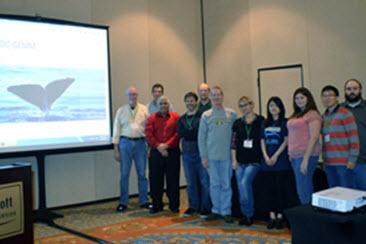
ingting Tang presents her research on whale population recovery at the 2016 Gulf of Mexico Oil Spill & Ecosystem conference in Tampa. (Photo provided by Tang)
When disaster strikes, responders look at how creatures in its path may be impacted to mitigate damage.
Tingting Tang takes the process one step further, using mathematical models to predict how long recovery may take. The creatures that Tingting focuses on are some of the Gulf of Mexico’s largest predators and most charismatic animals, beaked and sperm whales.
Working towards her Ph.D. in Mathematics at the University of Louisiana at Lafayette (UL Lafayette), Tingting is a GoMRI Scholar with the LADC-GEMM consortium. She describes how her love of math led her to study some of the world’s largest creatures.
Her path
Tingting, a native of China, had never been to the United States before pursuing graduate studies in Lafayette. “When I was a child, I had no idea that later in my life I would be studying marine mammals in the Gulf of Mexico,’ she recalled.

Sperm whales photographed by Franco Banfi (Copyright, Franco Banfi, all rights reserved. Image provided here as fair use for education purposes and to acquaint new viewers with Banfi’s work)
Always up for a challenge, Tingting found math appealing because it was the most difficult subject in school; however, as she grew older, she became captivated with it and its ‘simple beauty.’ Later she learned that math could address questions about her country’s large population. Tingting explained, “The idea of studying population structures became more attractive to me as I learned about powerful tools in mathematics.”
This interest led her to seek advanced math programs, and she earned degrees in applied mathematics and computer science from the East China University of Technology and Science in 2012. She took a big step away from home, enrolling in the UL Lafayette mathematics graduate program and then earning a Master’s degree with a concentration in applied mathematics.
UL mathematics and physics departments had ongoing studies on Gulf marine mammal populations that inspired Tingting to initially focus her research on disease epidemics. Her advisor Dr.Azmy Ackleh was impressed with her work and encouraged Tingting to join him and the LADC-GEMM team assessingDeepwater Horizon oil spill impacts on marine mammals. “I was very excited to be on the project,” said Tingting. “This was a great opportunity to apply what I have learned to a timely and interesting real world problem.”
Her work

The LADC-GEMM team for the 2015 Gulf of Mexico recovery cruise. From left to right: Douglas Dugas, Natalia Sidorovskaia, Tad Berkey (Captain), Sean Griffin, Tingting Tang, Kun Lee. Top right Bradley Lingsch and Carl Richter, bottom right Elizabeth Kusel and Sakib Mahmud. (Photo by Douglas Dugas)
Tingting described her daily research routine, “I often find myself losing track of time trying to solve a problem arising from modeling or debugging a program.” Yet, she feels that every day is an adventure, “I learn something new, which is my favorite part of being a research student.”
Her work has two parts: estimating the number of whales and assessing environmental impacts on them. Tingting analyzes population density trends of beaked whales using data collected near the spill site in 2007, 2010, and 2015 by LADC-GEMM’s acousticians, led by Dr. Natalia Sidorovskaia. Tingting uses this data to develop statistical and mathematical models and obtain population density estimates.
Tingting assesses environmental impacts on marine mammals with a life-stage matrix population model to analyze changes in sperm whale population dynamics. Her study uses a mathematical model based on a five-stage life cycle that divides the female population into calves, juveniles, mature females, mothers, and post-breeders. A potential impact of the oil spill on the sperm whale population could be reflected in reduced adult female vital rates. Tingting uses the model to describe the population dynamics and derive recovery probability and time under different impact levels. For example, if the adult female survival rate is reduced by 1% for 20 years due to a certain event, how long would it take for the whale population to recover to pre-event levels? What if the reduction is 3% and lasts for 30 years? The stage-structured population model can help provide insights into questions like these.

The LADC-GEMM team memebrs during the 2016 Gulf of Mexico Oil Spill and Ecosystem Science Conference. From left to right: Hal Caswell, Chris Tiemann, Azmy Ackleh, Dave Mellinger, Chris pierpoint, Stan Kuczaj, Natalia Sidorovskaia, Danielle Greenhow, Tingting Tang, Kun Li, Ross Chiquet. (Photo provided by Tingting Tang)
Previous research by LADC-GEMM indicates that sperm whales relocated to sites farther away from the spill. Tingting’s preliminary findings on beaked whales, however, suggest that they remained in the area, though she is not certain what specific factor(s) prompted the different migratory behavior of beaked and sperm whales. She learned that both whale populations are fragile and particularly sensitive to changes in adult female vital rates. Even slight changes in adult females’ mortality or reproduction rates can result in population decline. Tingting completed analysis of the 2007 and 2010 acoustic data and hopes to analyze the 2015 data after others process it. Doing so will give her a longer timeline of the whales’ density trends so she can understand whether whales have returned to pre-spill numbers and predict their future populations.
Her learning
Tingting credits her advisor Dr. Ackleh with mentoring her towards her goals and teaching important research techniques, including exhaustive literature searches to refine her methodology. She also joined a LADC-GEMM research cruise in October of 2015 to recover equipment deployed in an earlier trip. She observed field-work processes, assisted in equipment recovery, and learned details of how data is collected. She feels very fortunate to work on such a large-scale project as a graduate student, particularly one with so many talented people. “I am truly thankful for the opportunity to join the GoMRI science community,” she added.
She participated in the 2016 Gulf of Mexico Oil Spill and Ecosystem Science conference, “I was very excited but nervous standing by my poster,” Tingting said. “But as the poster attracted more people with questions and interest in our findings, I felt proud and accomplished explaining our methodology.” She is looking forward to presenting more results in the coming year.
Her future
Tingting plans to complete her Ph.D. in the summer of 2017. She hopes to secure a postdoc position, continue her population dynamics studies, and build a solid resume of published research. Her dream is to land a tenure-track position at a research institution, “I hope one day I can be as good as a researcher as my advisor Dr. Ackleh.”
Tingting would love for all aspiring scientists to embrace the beauty of mathematics as a research tool. She says that the right tools coupled with the right attitude can bring success in science. “For students considering science as a career, I would say endurance, persistence, and hard work will not fail you.”
Praise for Tingting
Describing Tingting as hardworking and smart, Dr. Ackleh said, “What distinguishes her from other students is her leadership skills.” He has watched her, even as a young Master’s student, lead meetings that involved older students further along in their research. She helped the team attend this year’s Gulf of Mexico Oil Spill & Ecosystem Science conference, organizing travel, working with a postdoc on the presentation poster, and driving a group to Tampa.
Tingting joined Ackleh as an author on an earlier article funded by the National Science Foundation regarding disease epidemics, and they are preparing a manuscript for publication. Ackleh said that Tingting was a main driver of that paper, contributing as much as anyone else on the project. She is also a co-author with Ackleh and other LADC-GEMM team members on a recently-submitted paper about their research using stochastic modeling to analyze effects of environmental stressors on sperm whales.
The GoMRI community embraces bright and dedicated students like Tinting Tang and their important contributions. The GoMRI Scholars Program recognizes graduate students whose work focuses on GoMRI-funded projects and builds community for the next generation of ocean science professionals. Visit the LADC-GEMM website to learn more about their work.
************
This research was made possible in part by a grant from The Gulf of Mexico Research Initiative (GoMRI). The GoMRI is a 10-year independent research program established to study the effect, and the potential associated impact, of hydrocarbon releases on the environment and public health, as well as to develop improved spill mitigation, oil detection, characterization and remediation technologies. An independent and academic 20-member Research Board makes the funding and research direction decisions to ensure the intellectual quality, effectiveness and academic independence of the GoMRI research. All research data, findings and publications will be made publicly available. The program was established through a $500 million financial commitment from BP. For more information, visit http://gulfresearchinitiative.org/
